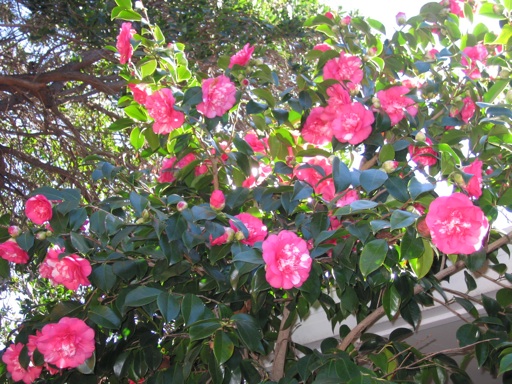
There’s not much going on in our yard right now. Most of our perennials are deciduous and are currently in their dormant phase. The only plants that are in full bloom in our yard are the camellias. This picture shows the Faith Variegated camellia bush that is blooming outside our bedroom window. Every year it fills up with pink flowers from January through March. They are beautiful flowers, although they don’t have any detectable fragrance.
Camellias tend to be a bit messy during bloom time. The flowers fall off the bush completely intact before they wilt or turn brown. They don’t fall apart petal by petal like roses. After a few weeks of blooms, the ground underneath the bush is full of pink flowers. Also, camellias don’t make great cut flowers, in my opinion, because they tend to fall off the stem in just a few days. Yet, despite the mess, they are one of my favorite garden plants, because their flowers and leaves are so attractive and eye catching.
February 07 2009 | Camellias | Comments Off on More Faith Camellias
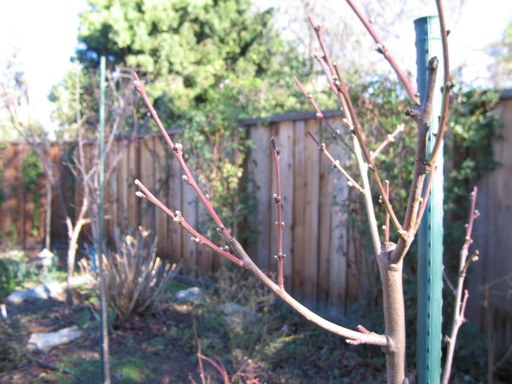
On Friday, I sprayed my peach and nectarine trees to control peach leaf curl. I also sprayed them in late December. I have been spraying my peach tree twice each winter while the tree is dormant since I planted it back in 2002.
I have heard people coming into our local nursery complaining about peach leaf curl in the spring. Unfortunately, it is too late to spray then. The spray needs to be applied at least once while the tree is dormant. I typically spray twice. In very wet years, I spray three times.
Now is the time to spray peach and nectarine trees to control the leaf curl fungus. I have read that the most important time to spray is just as the buds are beginning to swell, and before the blossoms open up. With all of the warm weather we have been having in the past month (today the high temperate neared 70 degrees again), the buds on my white nectarine tree are staring to swell (see above picture). I expect it to bloom before the end of February.
February 01 2009 | Peaches/Nectarines | Comments Off on Spraying Peach/Nectarine Trees to Prevent Leaf Curl
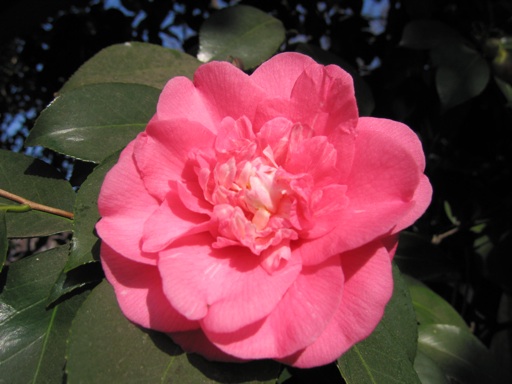
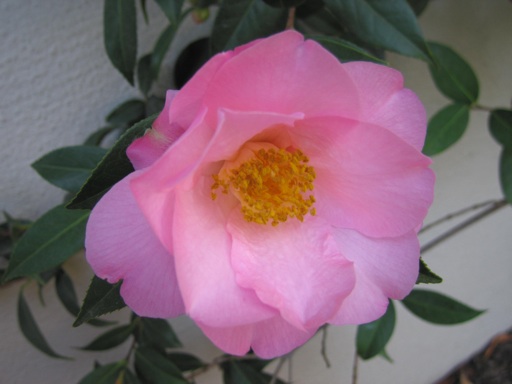
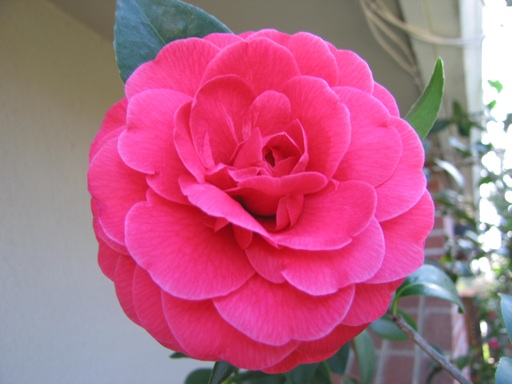
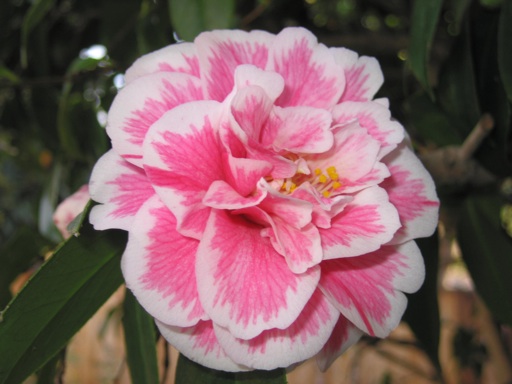
The previous owners of our house planted several camellia bushes next to the house. They look to be at least a few decades old. We are now enjoying the benefits as they begin blooming for another season.
Our camellias typically start blooming in January and continue through April. Camellias are one of my favorite flowers. They make great backyard landscaping plants for the appropriate climate. Even after blooming, their glossy attractive evergreen leaves keep them looking good throughout the summer and fall months.
The high temperatures here have been in the upper 60s and low 70s F for over a week now. Normally, the high temperatures here in January are in the 50s. Several of our camellias have started to open their first sets of flowers in the last few days, as shown in these pictures. The warm weather seems to be the cause.
Camellias prefer a shady location. Luckily, our camellias were astutely planted on the north-east and north-west sides of the house, where they only receive a minimal amount of direct sunlight. They are taller than the house now, and their top branches receive sunlight most of the day. But they don’t seem to mind as long as their lower branches are shaded.
The camellias in the the first, third, and fourth pictures above are most likely camellia japonicas. My best guess is that the camellia in the first picture is Faith Variegated, and the camellia in the fourth picture is Jordan’s Pride. I’m not sure what the others are.
January 18 2009 | Camellias | Comments Off on Camellias in January
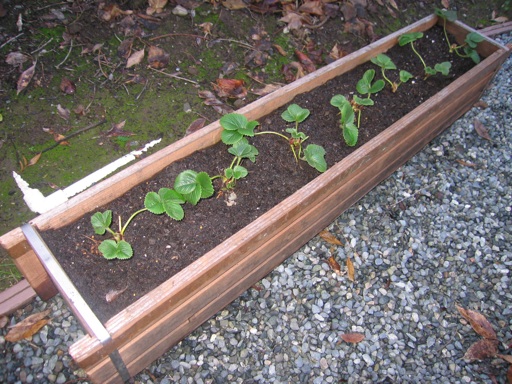
Strawberry plants proliferate by sending out runners that look like vines. The runners grow and develop roots that form new strawberry plants. Last summer, I let our strawberries send their runners into the raised beds where we grow our vegetables, because I wanted to get more strawberries for next year. The strawberries are growing in about ten pots next to the raised beds.
I spent part of the day yesterday and today transplanting most of the runner sets into pots, as in the picture above. Strawberries transplant incredibly well. I often tear off many of the roots in the transplanting process. They don’t seem to mind though. The strawberries don’t wilt or show any sign of transplant shock even after multiple transplants.
I also trimmed the new and old strawberry plants. The older plants look especially scraggly right now. They are full of dead and yellow leaves. I cut off most of the leaves of each plant, including many of the green leaves, leaving just the newly developing leaves. It seems that trimming the strawberries each winter helps stimulate them to regenerate in the spring.
After about 3 years, strawberries begin to produce fewer berries. I keep individual strawberry plants about 3-4 years before discarding them. I don’t think that growing them as annuals is the best method. In general, our strawberries have reached their peak production of berries at about 2 years from the time they rooted as runners. I don’t see the point of throwing away good plants until they are past their peak. We are growing Sequoia strawberries. Sequoia is a particularly tasty variety that grows well in California.
I am still toying with the idea of leaving some of the strawberry runners to grow in one of the raised beds. I have had a lot of success so far with growing strawberries in pots. Although, I have a tendency to plant them too close together in the pots. I keep underestimating how large they will get, so they end up looking crowded. I think I will plant just one row of them in one of the raised beds with each plant about 12 inches apart, and then judge how well they perform in 2009. Hopefully, they won’t proliferate like mad and take over the garden.
December 29 2008 | Strawberries | Comments Off on Transplanting Strawberries

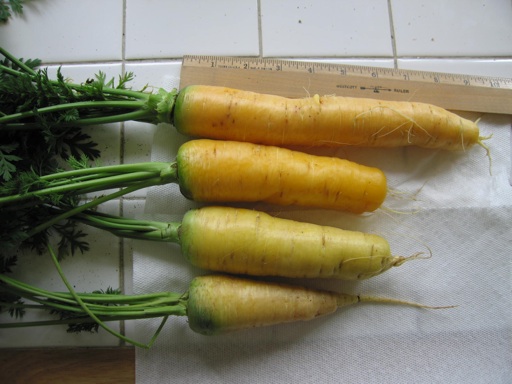
Nearly all of the plants in our vegetable garden are dead or dying. The one exception is the carrots I planted by seed last summer. We planted yellow and red carrot seeds, because we thought they would be interesting novelty plants. The carrots look healthy right now despite the cold weather we have been having.
Several nights last week, the temperatures here fell into the low 30s F. The frost damaged the leaves of our brugmansia and plumeria plants. However, the carrots appear to have been unaffected by the cold temperatures. The leaves still look green and healthy. The high temperatures here have been in the upper 40s to low 50s for weeks.
Today, I harvested our first carrots, shown in the above pictures. Obviously, one doesn’t know what an individual carrot will look like until it’s uprooted. So I was very excited to pull them out of the ground and discover nicely developed carrots attached to the leaves. The surprise factor adds an interesting dimension to growing carrots. These appear to be yellow carrots. The largest one is about 9 inches in length. The thickest one is about 1.75 inches in width. I can’t wait to taste them. We are going to serve them for Christmas eve dinner. I haven’t grown carrots since I was a child, and I remember not having much luck with them back then.
I have read that one of the keys to growing carrots is to grow them in at least a foot of loosely packed soil that is free of rocks. Otherwise, the carrots may not develop to their full length or may develop forks. Growing them in a foot-high raised bed filled with compost seems to have helped.
December 23 2008 | Carrots | Comments Off on Yellow Carrots
« Prev - Next »








